Have you ever wondered how the Pyramids of Egypt were built? The ancient Egyptians crafted these massive structures, which still stand tall after thousands of years. They hold secrets of ancient Egypt’s civilization. We will explore the mysteries of the pyramids and uncover their construction, purpose, and legacy.
Many think the pyramids, like the Giza complex, were erected near a lost branch of the Nile. This idea might explain how the ancient Egyptians used special methods for building. It also suggests the river helped transport the huge stone blocks to construct these great tombs.
Let’s embark on a special journey to discover Egypt’s ancient wonders. We will reveal the unknown stories of the pyramids. This adventure will showcase the brilliance and majesty of ancient Egypt. It will share the secrets of these structures, which still intrigue and amaze us today.
The Purpose of the Pyramids
The pyramids in Egypt are symbols of the amazing things ancient Egyptians could do. Even today, we aren’t sure completely how they were built. But we know they were made for a very special reason.
The main goal was to build big tombs for the pharaohs and important people of Egypt. These structures marked where these powerful people were laid to rest. It was also to show how wealthy and powerful they were, even after they had passed away.
Over 100 pyramids have been found by researchers, mostly near the Nile’s western bank. This positioning was very likely tied to the way the sun moved each day. It was seen as a part of the pharaoh’s journey after death, their rebirth, and rise into the next life.
The ancient Egyptians believed their pharaohs were more than just kings; they could become gods after they died. Inside the pyramids, everything was carefully prepared. They packed treasures and items that would help these leaders in their spiritual journey.
“The pyramid is a symbol of the pharaoh’s power, a testament to their grandeur and their belief in life after death.” – Egyptologist Dr. Zahi Hawass
Building a pyramid was a long, complex process. It took many years and a lot of people to complete. These included skilled workers, laborers, and craftsmen. The planning and hard work that went into building these monuments are truly incredible.
Walking through the secret parts of the pyramids gives us a small look at Egypt’s rich history and beliefs. The mystery behind these wonders is a big draw for those who study or just enjoy ancient history. It pushes us all to learn more about how the ancient Egyptians saw the world.
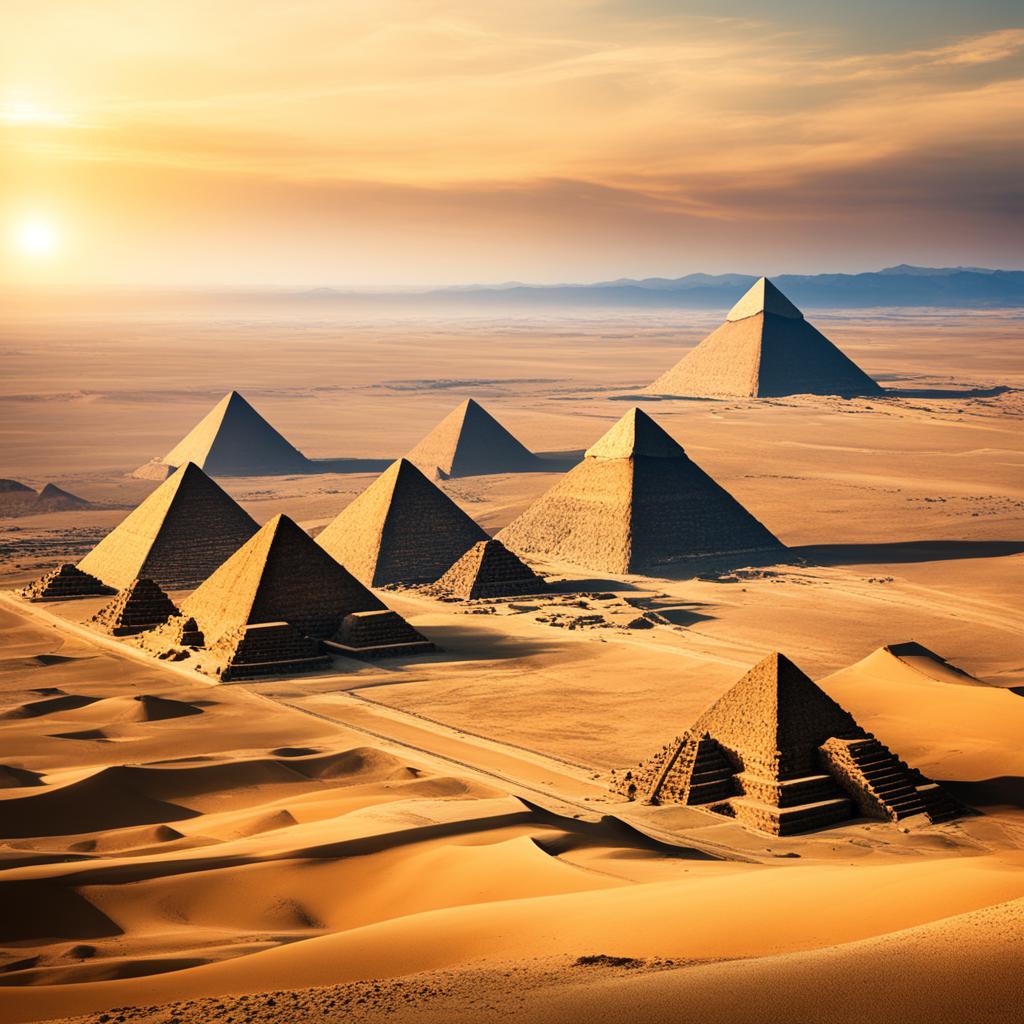

The Power of Eternal Rest
The pyramids have hidden rooms and passages that include beautiful sarcophagi. It is believed these were designed to keep the pharaoh’s body safe forever. The walls tell stories of the pharaoh’s life and what they achieved. This turns these structures into histories written in stone.
The pyramids are now famous symbols of ancient times. They remind us of the great pharaohs and their never-ending search for a life that goes beyond death.
Construction of the Pyramids
Building the Pyramids of Egypt is a big mystery still discussed today. Some experts think they used wet sand to slide the giant stones on sleds in the desert. They also used ramps to place the blocks where they needed to be.
It’s unclear how they lifted the stones, but they might have used sleds or rollers. The huge weight of the stones and the pyramid’s steep slopes made it really hard. It took a lot of work and smart thinking.
To put these stones in place, they had to use sleds, ramps, and many other clever methods. These methods show how skilled the ancient builders were.
Imagine moving huge stones long distances on sleds in sand. Think about how complex it was to raise them into the pyramid’s structure.
The construction of the pyramids was a testament to the ingenuity and dedication of the ancient Egyptians. The precision in the placement of these massive stone blocks is awe-inspiring and leaves a lasting impression on visitors to this day.
The Challenges of Construction
Moving the heavy stone blocks was a tough job. They used sleds and ramps to make it easier. Sleds helped the blocks slide across the sand, and ramps helped lift them up.
The pyramid’s steep slopes made things even harder. The builders had to make sure the stones were stable and in the right place. This was crucial for the pyramid’s shape.
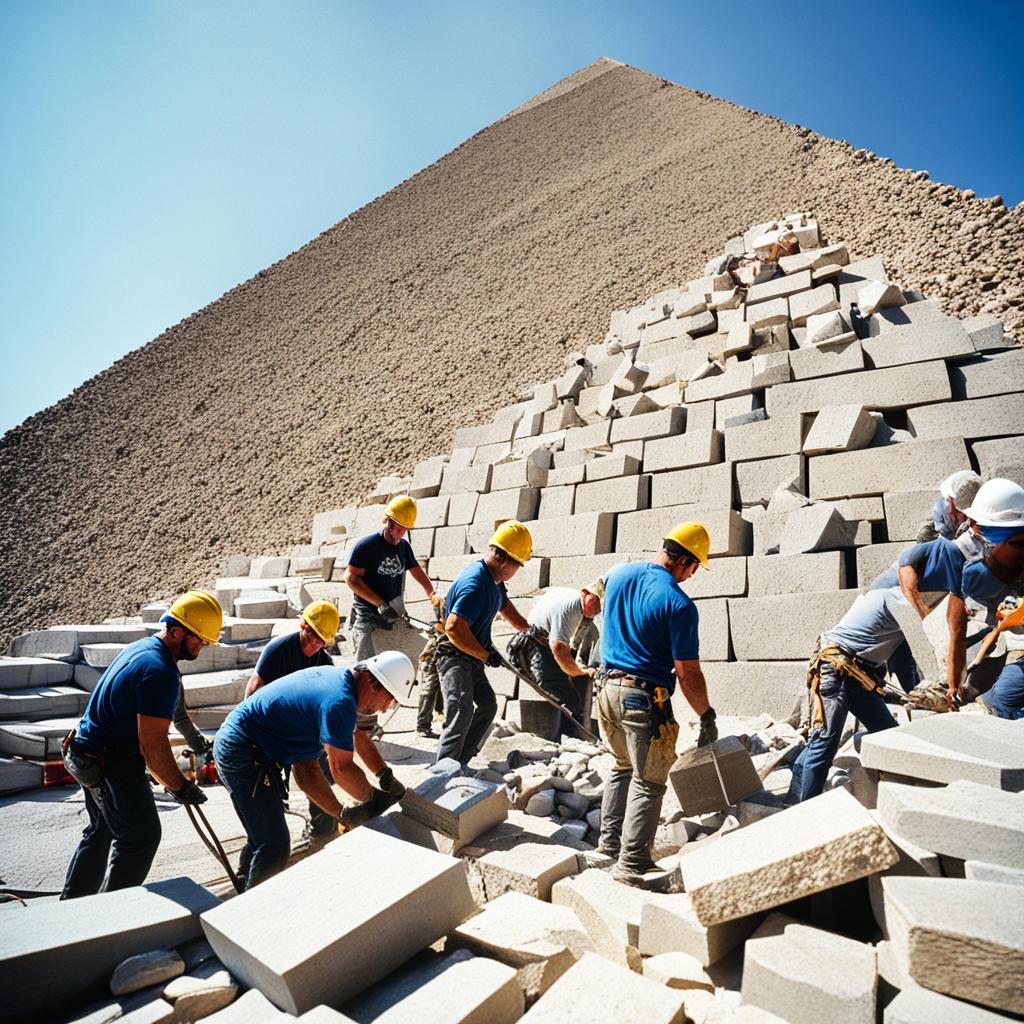

The image above shows how the builders used sleds, ramps, and their manpower. They used these tools to move and put the stone blocks in place. It’s a great example of the clever methods the Egyptians used.
Building the pyramids was a huge task that needed planning and teamwork. Whether you’re a historian or a visitor, the mystery of how they built the pyramids is fascinating. This mystery adds to the wonder of the Pyramids of Egypt.
- The use of sleds, ramps, and wet sand lubrication allowed the transportation of stone blocks.
- Construction required precise positioning of the blocks despite steep angles.
- The image above provides a visual insight into the construction methods employed by the ancient Egyptians.
The Great Pyramid of Giza
The Great Pyramid of Giza is the biggest Egyptian pyramid. It’s also called the Pyramid of Khufu or Cheops. This magnificent ancient structure draws people in with its sheer size and hidden stories. The way it was built is still a big mystery.
This pyramid stands mighty at about 481 feet high. It was the tallest building made by humans for 3,800 years. The sheer scale shows how skilled the ancient Egyptians were. They used 2.3 million stone blocks, each weighing from 2.5 to 16 tons. Building it was a huge challenge, yet they did it.
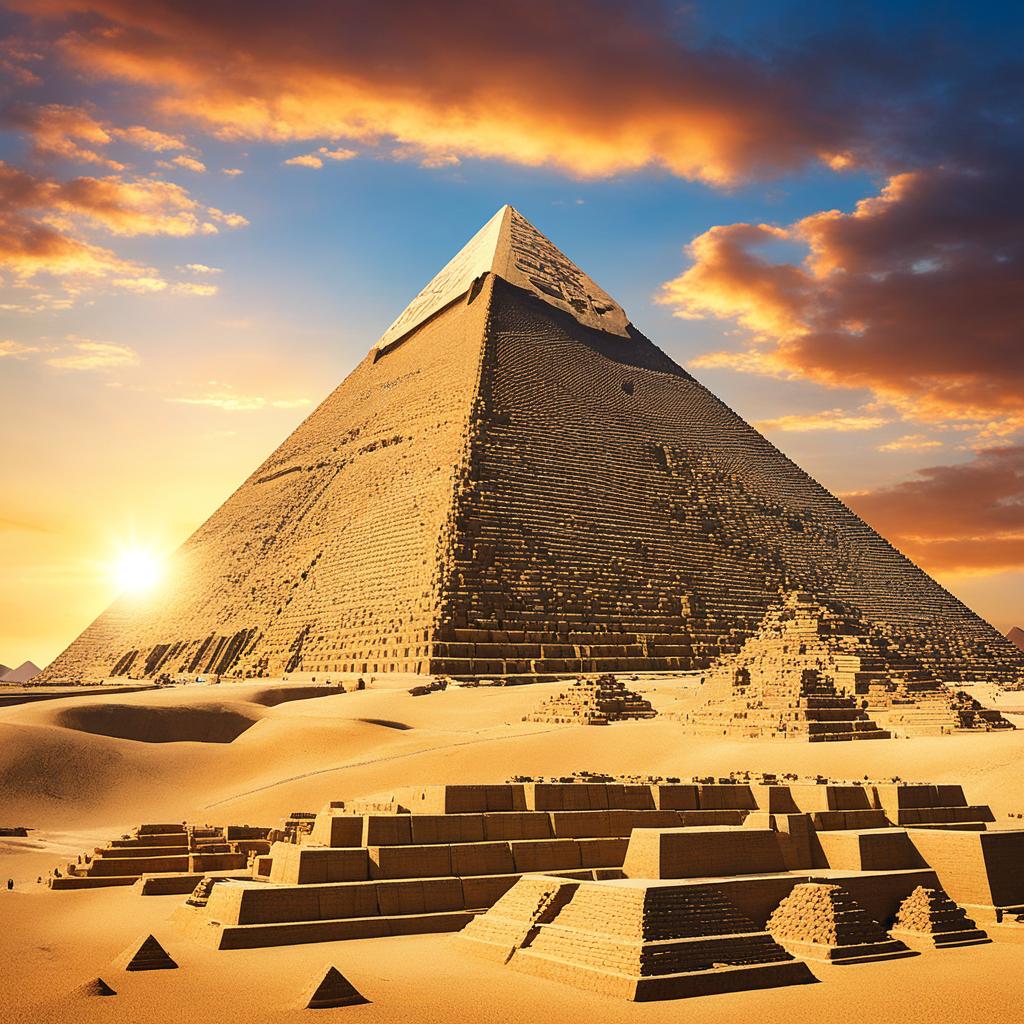

It’s thought that the Great Pyramid was finished in about 20 years. Many, many workers were needed to build it. The way it was designed and built still impresses people today.
How they built such a massive and accurate structure is still debated. Some think they used ramps and sledges to move the stones. Others say they might have used ramps inside. But, we’re still not sure, adding to the pyramid’s mystery.
“The power and majesty of the Great Pyramid is unmatched. Its construction still baffles experts, and its size and precision continue to amaze visitors from around the world.” – Egyptologist, Dr. Samir Farag
We’re still looking into what the Great Pyramid was really for. While many think it’s a tomb for Pharaoh Khufu, its design has hidden rooms. This hints there is more we have yet to find.
The Great Pyramid shows the ancient Egyptians’ skill and the many mysteries of their culture. Its huge size, perfect building, and unknown secrets make it a top spot for anyone loving olden times and wonder.
The Secrets within the Pyramids
The pyramids of Egypt hide many secrets. Even after centuries, we are still discovering new things. Thanks to the ScanPyramids project, we are using new scanning methods to learn more.
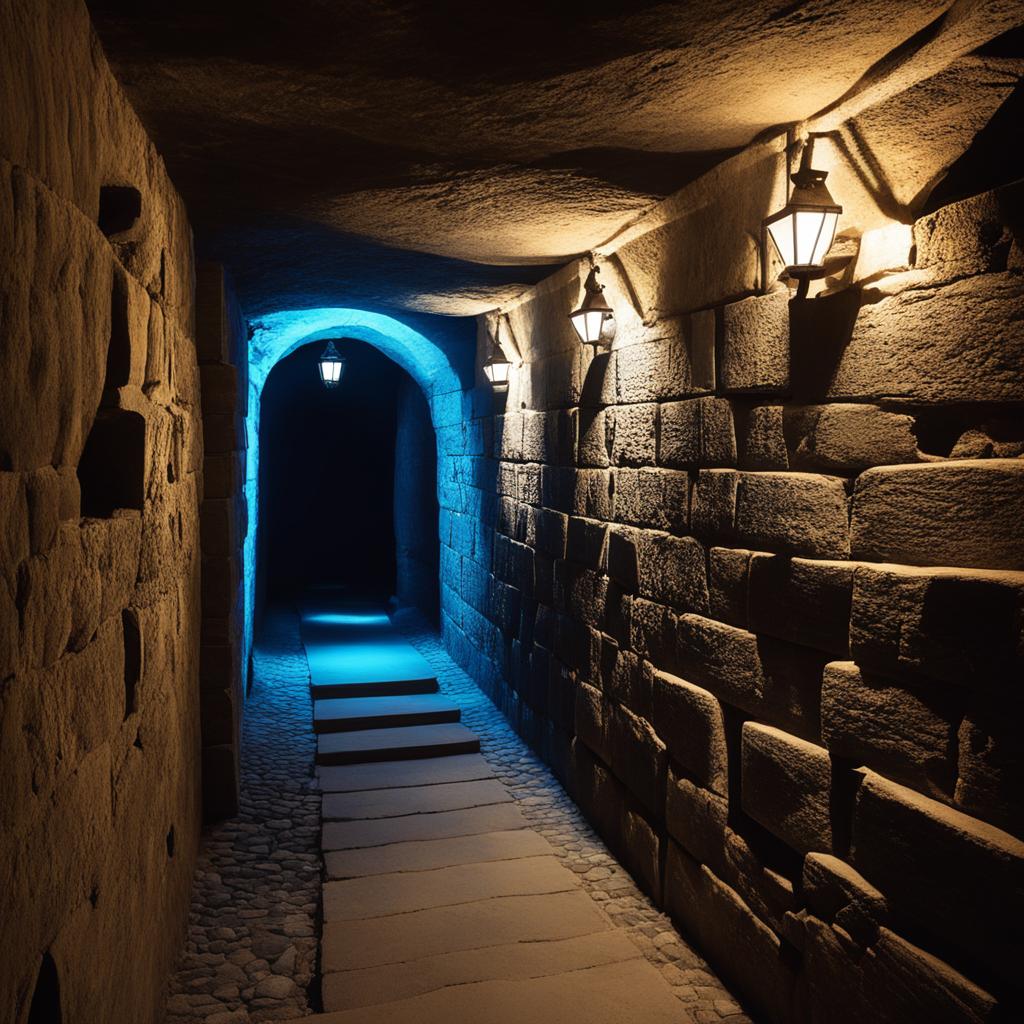

This project is using advanced technology to scan the pyramids. They found new chambers and spaces that were unknown. This has given us more information on how and why the pyramids were built.
In 2017, a major discovery was made in the Pyramid of Khufu. Two new voids were found for the first time in over a hundred years. This amazed everyone, as it hinted at a hidden purpose.
What’s inside these chambers is still a mystery. But, finding out could change what we know about the pyramids. This might teach us more about how they were built and all the work that went into them.
Future Revelations through Cutting-Edge Technology
The ScanPyramids project is leading the way in exploring the pyramids. Its scanning methods are opening new doors for research. They are helping us better understand the pyramids’ secrets.
This new way of studying excites and challenges researchers. The mystery of the pyramids keeps them motivated. They are eager to see what more they can discover.
The End of Pyramid Construction
The building of pyramids in Egypt stopped about 1500 BCE. A theory says people started burying pharaohs underground because of religious changes. Pharaohs were then laid to rest in the Valley of Kings, close to Thebes.
This change happened because it was safer. Tomb robbers were a big problem. The Valley’s rock-cut tombs were better protected. Also, the hot and cold weather in the desert made maintaining pyramids hard.
The Survival of the Pyramids
The pyramids of Egypt are ancient wonders that have lasted through the ages. The Great Pyramid of Giza, in particular, stands tall as the last wonder of the ancient world.
Despite their age and many challenges, these pyramids have survived. They beat nature’s powers and any attempts to destroy them. This has kept the world amazed by their beauty and history.
The Egyptian pyramids have faced the desert’s heat and Father Time with grace. They stand as a tribute to the ancient builders’ skill and creativity.
Many old structures fall over time, but not the pyramids. Their lasting power is amazing, making people wonder about the ancient Egyptians.
The pyramids of Egypt have fascinated and mystified generations of people, their survival a testament to the ingenuity and craftsmanship of the ancient Egyptians. As the only surviving wonder of the ancient world, the Great Pyramid of Giza serves as a constant reminder of the magnificence and enduring legacy of these ancient tombs.
The pyramids have lost their outer layers to time and weather. Yet, they still stand, showing life’s power over destruction.
Their continued existence is a win for all who treasure these ancient symbols. They offer us a peek into ancient cultures, their beliefs, and skills.
As we look at the pyramids today, we see what people can achieve. These structures are still full of mystery, inspiring us with their story and grandeur.
The Population of Pyramid Builders
The building of Egypt’s pyramids is a fascinating mystery for experts. They wonder how many workers built them. Herodotus thought 100,000 people worked on the Great Pyramid of Giza. But, recent findings suggest around 20,000 workers might have built it.
These builders were mainly farmers. They worked during the Nile’s floods when farming was slow. With basic tools, they worked hard to create the pyramids.
“The exact number of pyramid builders is tough to pin down. Estimates change based on what history tells us and new digs.” – Dr. Emily Wilson, Egyptologist
Figuring out how many workers built the pyramids matters a lot. Though not as many as once guessed, their work is still amazing. It shows their dedication and their creative techniques back then.
The Impact of Labor
The builders’ work on the pyramids was critical. They moved huge stone blocks. Each block was carefully placed to make the pyramids stand beautifully. Their skills and hard work made the pharaohs’ tombs a reality.
Theories and Controversies
Even with new discoveries, we’re still not sure exactly how the pyramids were built. Some say they used advanced tools. Others believe it was the workers’ brilliant ideas that got the job done.
- The Rope Rollers Theory: This theory suggests they used big wooden rollers to move blocks. This way, less effort was wasted.
- The Ramp Construction Theory: Another idea is that they built ramps next to the pyramids. These ramps helped move stones more easily.
It’s possible they used a mix of these methods. What we do know is there’s a lot we still don’t understand about how the pyramids came to be.
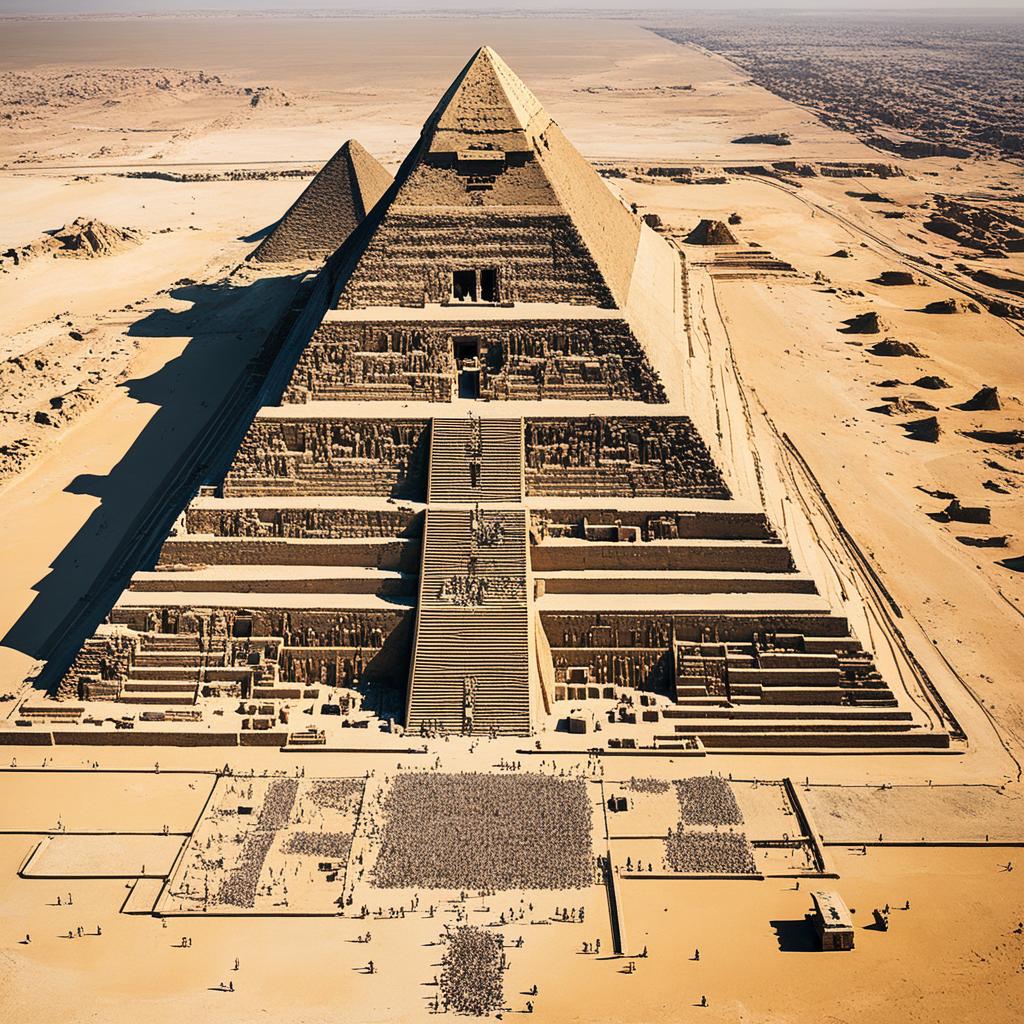

The pyramids symbolize the ancient Egyptians’ genius and cultural importance. They stand as proof of what people can achieve. They inspire wonder and curiosity in all who see them today.
The Preservation of the Pyramids
The pyramids in Egypt have lasted for centuries. Yet, challenges in keeping them safe are real. Changes in temperature and the loss of outer layers threaten these great structures.
Made from limestone or marble, the outer casings of the pyramids are falling away. The hot desert climate in Egypt plays a big part. This weather makes the limestone expand and then contract. As this happens, it cracks and wears down, revealing the core of the pyramids.
“The preservation of the pyramids is a constant battle against the elements. The extreme temperatures in the arid climate have hurt these old structures. But, the damage hasn’t destroyed the core, showing the incredible skill of the ancient Egyptians.”
The Bent Pyramid is a unique exception. It stands out for its different shape. The sloping design of its sides and the gaps between stones help against extreme heat. This design allows for less damage from the changing temperatures.
Preserving the Legacy
There are ongoing efforts to save the pyramids. These projects aim to keep them from getting worse. They use advanced methods like laser scanning and reinforcement to protect them.
Keeping the pyramids safe is crucial. It helps protect their historical and cultural importance. By doing so, we can learn more about ancient Egypt. It gives us clues about their incredible architecture and beliefs.
Now, let’s explore the Orion Correlation Theory. It suggests a link between the pyramid positions and the stars of Orion’s Belt.
The Orion Correlation Theory
The Orion Correlation Theory links Egypt’s Pyramids to Orion’s Belt. Robert Bauval introduced this theory in 1983. He noticed the Great Pyramids mirror the alignment of Orion’s Belt stars.
This alignment has sparked a big debate. Some believe the connection is real. Others say it’s just a coincidence. The argument is over whether it was planned or accidental.
Imagine if the alignment was on purpose. What would that mean? Could it signal something deeply significant about the ancient Egyptians? Perhaps they saw the pyramids as bridges between our world and the stars.
This theory has fired up many imaginations. People, from scholars to fans, find it captivating. It keeps the mystery and the awe around the pyramids alive.
Controversies and Counterarguments
Not everyone agrees with the Orion Correlation Theory.
- Some say the alignment is accidental. This is because Orion’s Belt stars have moved slightly over many years.
- Others point out that Egypt has more pyramids than just three. They think focusing only on Orion overlooks a larger picture.
- Also, some skeptics mention the pyramids were not all built at the same time. So, aligning them with Orion could be pure chance.
To prove or disprove the Orion Correlation Theory, we need more study. It’s ongoing to fully understand what the alignment means.
Even with doubts, the theory has drawn wide interest. It highlights the pyramids as everlasting wonders. People everywhere still find them fascinating.
The Legacy of the Pyramids
The pyramids of Egypt are hugely important culturally and historically. They show the amazing skills of the ancient Egyptians in building and designing. Anyone who visits them gets a close look at the deep history and the mysteries of Egypt’s past.
These stunning monuments show off the Egyptian culture’s incredible achievements. Their huge size, accurate building, and detailed design still amaze. The pyramids prove how skilled the ancient architects and workers were, even without today’s technology.
The pyramids are more than just buildings; they are windows into the ancient Egyptians’ way of life. They were built not just for kings but also for the gods, showing the deep spiritual beliefs of the time. These structures were meant to help the kings reach a good place after their death.
“The pyramids are not only architectural marvels but also important cultural artifacts that provide insight into the ancient Egyptian civilization.” – Egyptologist Dr. Mark Collins
Even now, the pyramids draw people from all over by their mystery and beauty. They let us feel what it was like for the kings of old, and people travel far just to see them. This makes them a key part of Egypt’s tourism and helps their economy grow.
The pyramids are not just for looks; they play a big part in Egypt’s economy, drawing in many tourists yearly. The money from tourism helps keep these ancient wonders well-maintained for the future.
The Pyramids and Sustainable Tourism
Lately, there has been a push for tourism around the pyramids to be more sustainable. Places like this need special care to last a long time. Rules are made to make sure they stay safe for many years without losing their magic.
In the end, the pyramids symbolize human skill and a deep cultural heritage. They remind us of Egypt’s rich and impactful past.
Interested in exploring the pyramids of Egypt? Plan your visit and witness the marvels of ancient architecture and the wonders of ancient Egyptian culture.
Conclusion
The Pyramids of Egypt have always amazed people everywhere. Even now, after so much research, they still have secrets. We keep debating how they were built and why.
But, we all agree on one thing: the pyramids are super important. They show just how smart and skilled the ancient Egyptians were. The pyramids tell the story of an old, rich culture.
Seeing the pyramids up close is a must to truly get them. When you visit Egypt, you dive into the mystery and beauty of these huge structures. You’ll get to explore inside and feel the legacy of the past.
Standing in front of the Pyramids of Egypt makes you think deeply. They keep their ancient mysteries, which draw people from all over the world to Egypt. A trip to this country is like stepping into a history book, full of adventure and discovery.
